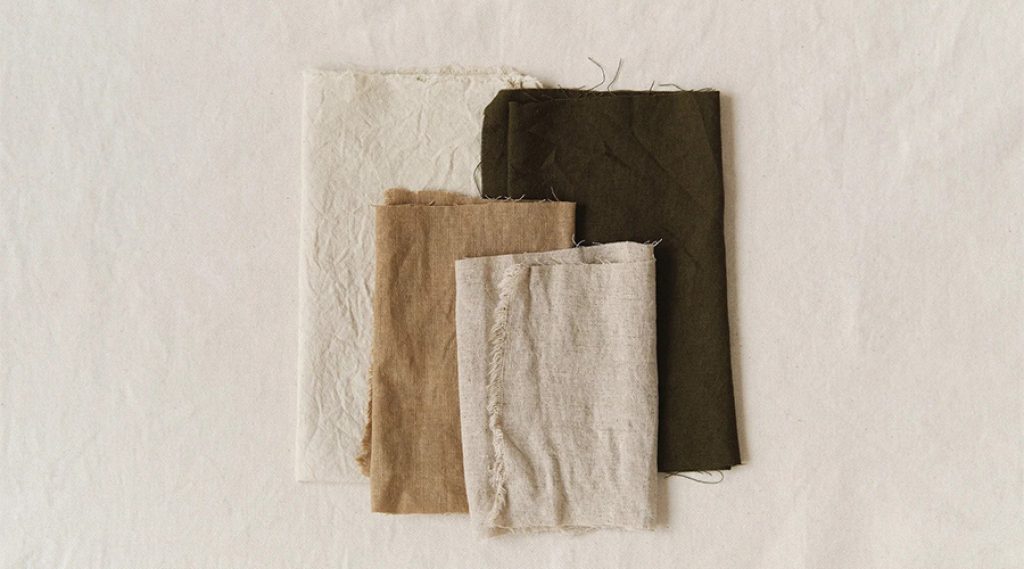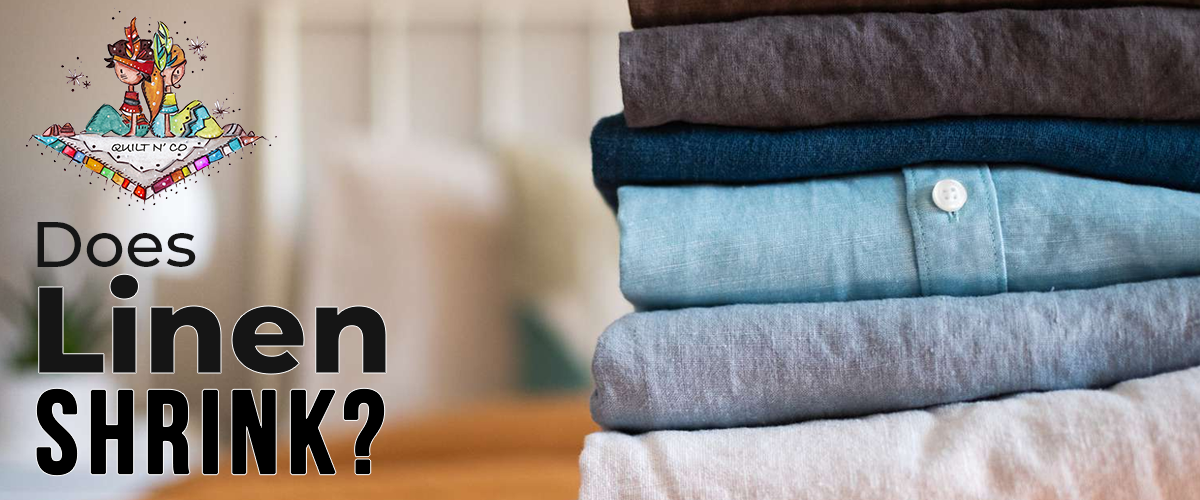Yes. Linen is prone when exposed to moisture and high temperatures. When you expose linen to heat and moisture, it can completely break down and become unusable. So, how do you care for this fabric?
Here we’ll go over the different ways you can prevent linen from shrinking. As well as how you can properly wash this fabric without destroying it. Let’s dive in!
What Is Linen?
Linen fabric comes from the stalks of flax plants. This plant is one of the oldest plants known to human history.
Linen is a natural fiber similar to cotton, but it takes longer to produce because flax is harder to harvest. Flax also needs to be stored longer for it to soften. Linen is known for its durability and strength.
It is a versatile fabric that can be used in many ways. One of its most profound features is how absorbent it is. It’s capable of absorbing up to 20% of its own weight making. This is one of the primary reasons that linen is used in sportswear.
Why Does Linen Shrink?
Linen shrinks because of how it’s made. Flax plant fibers are stretched to create linen. When these fabrics are exposed to water, they shrink.
Linen shrinks because the high temperatures of water cause the fibers to relax and return to their original size. This gives the illusion that it’s shrinking.
One of the reasons linen is susceptible to shrinkage is that plant fibers are more susceptible to shrinkage and high water temperatures than animal fibers such as wool. ‘
Linen will shrink in both hot water and cold water. But it will experience greater shrinkage in the hot water than in the cold water. This is mainly because the hot water relaxes the fibers much more than cold water does.

How Much Does Linen Shrink?
The severity of Linen shrinkage depends on the kind of linen you have. On average, linen shrinks around 3% to 4%. In some cases, linen can shrink up to 10% after washing.
In most cases, if linen is not pre-washed, it can shrink between 10% and 15% after the first wash. To prevent this level of shrinkage – look for linen clothes or material that is pre-washed. This will keep the shrinkage to a minimal after the first wash.
Don’t be mistaken, linen does not only shrink after washing, but it can shrink after drying as well. At high temperatures, linen can shrink up to 10%. The higher the drying temperature the more that the linen will shrink.
To avoid shrinkage while drying, it’s best to dry on low heat or no heat. This will keep the fibers stretched out and won’t cause them to relax and shrink.
Can You Wash Linen Without Shrinking It?
Since water causes linen to shrink, it is nearly impossible to wash it without some shrinkage. While you can’t stop shrinkage completely, you can reduce the amount of shrinkage.
There are a few things you can do to reduce the shrinkage when washing your linen.
When washing linen in the washing machine, the steps above will help reduce the amount of shrinkage. To reduce shrinkage proper care needs to be taken when washing linen.
Does Linen Shrink When Washed In Cold Water?
Yes, linen does experience some shrinkage using cold water. Although it does shrink more with hot water you can stop the shrinkage in cold water also.
To minimize the amount of shrinkage when using linen you want to use room temperature water. Extreme temperatures whether they are cold or hot will cause shrinkage.



Does Linen Shrink When Dry Cleaned?
Yes, unfortunately, linen does shrink when it is dry cleaned. Most people assume that linen will not shrink when dry cleaned because it is not coming in direct contact with water.
Unfortunately, this is not the case. Since linen is extremely absorbent, it absorbs the water from the steam. The absorbed water is hot and will cause the linen to shrink.
When dry cleaning the shrinkage is mild compared to what you would experience with a traditional washer but there is still shrinkage nonetheless.
How To Prevent Linen From Shrinking In The Dryer?
Although you can’t prevent shrinkage when washing linen, you can do so when drying. The best way to prevent shrinkage when drying linen is to be careful with the amount of heat you use.
For the best results, dry linen without any heat or on the lowest heat option on the machine. It’s also important to monitor the time your linen spends in the dryer. Overdrying the linen will cause linen to shrink. Remove the linen from the dryer as soon as it’s dry to the touch.
While there is no exact time that will produce the perfectly dried linen. It will depend on your dryer, heat level, and size of the load. The best way to monitor your linen in the dryer is to set the dryer in increments and continue checking the temperature of the linen.
Although this can be tedious it will produce the best results. Once you have an idea of the amount of time it takes to properly dry your linen you can repeat this process in the future.
It’s also important to note that hang drying linen is not recommended. Doing so will cause the linen to stretch. The weight of the water will pull the linen down and cause it to stretch. It’s best to check the care instructions for your linen clothes before you decide on the drying option you want to use.
Can Linen Shrink More Than Once?
This is a common question for linen fabrics because we tend to use them every day.
For example, household items such as bed linens, curtains, tablecloths, and clothes are often linen. These products are used daily and require more frequent washing than other household fabrics. Due to the frequent washing, there is a misconception that the fabric will continue to shrink.
It’s important to note that only a certain amount of shrinkage can occur on a single piece of fabric. Once the fibers shrink back to the original length, they will not shrink anymore. But after using it, it will stretch. After washing again, it will reshrink and return to its original state.
Pure linen improves its quality with frequent wash if correctly done. Your linens will be softer to touch. Linen items like this will continue shrinking if not washed and dried properly. But the good news is that you can put them back to its brand new size by rewashing it and ironing it well.
One of the biggest issues with washing and shrinking linen multiple times is that over time this will put stress on the fibers. The stress on the fibers can cause the fibers to break. With time, this will destroy the fabric and it will become unusable.
Quick Tutorial
If you are short on time, this is a better method.
How To Shrink Linens?
If you want to shrink linen on purpose there are a few easy steps you can follow
This is easy if you have a washer and dryer. If you don’t have those at your exposal.
You can boil some water and place the silk inside once it’s boiling. When doing this method keep track of time. Overboiling your silk can cause permanent damage.
Drying is a bit more difficult to do without a machine. First, you can start by hanging it to dry out in the sun. To add finishing touches use a blow dryer to add finishing touches.
Does Linen Shrink More Than Cotton?
The extent of fabric shrinking comparison may depend on what cotton you are using. Pure cotton shrinks just as much as linen.
Manufacturers usually blend cotton and synthetic fibers like rayon or polyester and these blends shrink differently. Just like linen, the manufacturing process of cotton stresses the thread, when the heat is applied to the material it will return to its natural form thus making the fabric shrink.
This phenomenon is also known as relaxation shrinkage. Some linen producers pre-shrink their cotton to lessen the possibility of shrinking. This works most effectively when fabric owners follow the care specifications.
They can also prevent this by pre-washing cotton or linen in cold water either through hand washing or gentle machine wash.
Does Linen And Rayon Blend Shrink?
Yes, linen and rayon blends shrink. Both these materials alone are prone to significant shrinkage. Linen will shrink in both cold water and hot water. Although shrinkage is more pronounced in hot water there is some shrinkage during cold water as well.
Rayon is very prone to shrinkage as well, more so than linen. To prevent a rayon and linen blend from shrinking you should:
As an alternative, you can also dry clean a rayon-linen blend. While dry-cleaning may cause linen to shrink, rayon performs very well under dry cleaning conditions and it produces minimal shrinkage.
Conclusion
Maintaining your linen fabric is tedious. Without the extra care to care for your linens they won’t last.
In this article, you will learn exactly how to avoid shrinking your linen. Use this information to extend the life of your linen.













